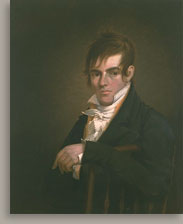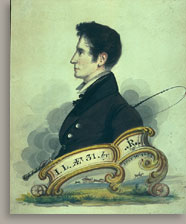 John Ritto Penniman John Ritto Penniman
Henry Nolen, about 1828–30
Description
Henry Nolen is a half-length portrait of a man facing three-quarters left and looking forward. His dark brown hair is combed into a tuft at the front of his head, and his long C-shaped sideburns trace his jawline. Nolen’s pronounced eyebrows form curves that complement the lines of his hair and sideburns. The sitter’s brow is furrowed with horizontal wrinkles and short lines that extend from the top of the nose onto his forehead. The sitter has blue eyes. His skin tones vary from red on his nose to lighter red on his cheeks and pink on his forehead. Nolen wears a dark blue coat with a black collar over a tan waistcoat and a white shirt. The shirt has a narrow collar that is starched and projects nearly horizontally from the neck in narrow triangles. Nolen wears a broad black stock at the neck, below which appears a small bit of white shirt ruffle. His right arm is draped over the back of a green carriage rail or chair back, which is visible at the bottom right corner of the painting.1 This seat is decorated with yellow, red, and black lines and a red and black stylized foliate design. The background of the portrait is olive brown.
Biography
Henry Nolen was born January 31, 1782 in Lynn, Massachusetts, on the North Shore of Boston.2 He was the ninth child of Thomas Nolen (1734–1785) and Elizabeth Blaney Nolen (1740–1802). Like Penniman, Henry Nolen was trained in Roxbury, Massachusetts as a decorative painter. The two men were contemporaries and perhaps even trained in the same shop. By 1809, Nolen was a chaise painter on Orange Street in Boston, and by 1813, he moved to Pleasant Street in that city. Penniman’s address was Pleasant Street by 1810.3 Like Penniman, Nolen’s name regularly appears in the account book of the cabinetmaker John Doggett (1780–1857), from whom they purchased supplies. Both Penniman and Nolen also did decorative work for Doggett. The bond between the two painters is further demonstrated in their marriage to two sisters: Penniman to Susanna (or Susan) Bartlett and Nolen to Elizabeth Bartlett.4 Nolen is listed in Boston city directories as a specialist in chaise painting. His brother Spencer (1784–1849) was also a craftsman, who worked in partnership with the clockmaker Aaron Willard, Jr. and later with Samuel Curtis.5
On December 16, 1812, Henry Nolen and Elizabeth Bartlett were married at the Hollis Street Church in the South End of Boston, the neighborhood in which Henry’s business was located. In 1813, the Nolens moved to West Brookfield, a country town about twenty miles west of Worcester. Nolen purchased a house on the road to North Brookfield and in 1819 bought land with carriage maker Nathaniel Spear on the West Brookfield town common. The two men constructed a brick house where Spear built and Nolen decorated carriages. The house was near that of the attorney Jesse Bliss and his wife Mary Penniman (1797–1837); she was the artist’s sister. The Nolens remained in West Brookfield until about 1839 when they sold their house and Henry’s share of the carriage business. They moved to Philadelphia, where Henry is listed in city directories as a "Fancy" painter. Nolen died there on September 9, 1860, and his wife survived him until 1879.6
Analysis
Henry Nolen is depicted as a middling craftsman with an ornamented carriage seat or chair included as a sign of his occupation as a decorative painter. Penniman represented his subject with his hair and sideburns neatly trimmed and his white shirt collar crisply starched. His brow is slightly furrowed with age and his features do not appear to be idealized.
Henry Nolen is the companion portrait of Elizabeth Bartlett Nolen (Mrs. Henry Nolen) (fig. 1). The heads of the two sitters are turned in three-quarters view toward one another, although their eyes return the gaze of the viewer. Both portraits are painted in a bust-length format on panel. Whereas the painted seat adds decorative interest to Henry Nolen’s portrait, Penniman developed Mrs. Nolen’s likeness with earrings, a lace-trimmed bonnet, a colorful ribbon, and a pleated collar.
 |
 |
 |
 |
|
Figure 1. John Ritto Penniman, Elizabeth Bartlett Nolen (Mrs. Henry Nolen), about 1828–30, oil on basswood panel, 19 3/4 x 16 9/16 in. (53 x 42.2 cm), Worcester Art Museum, Eliza S. Paine Fund, 1982.11. |
|
Figure 2. John Ritto Penniman, Spencer Nolen, 1806, oil on panel, 29 x 23 1/2 in. (73.7 x 59.7 cm). Courtesy of The Butler Art Institute, Youngstown, Ohio, Gift of Mr. and Mrs. Kurt Albrecht. |
|
|
|
|
The Nolen portraits reflect Penniman’s mature portrait style. In his earlier work, Penniman attempted to distinguish his decorative painting style from his fine art style. His work in the 1820s suggests that he blended the two interests in a way that was appealing to his friends, family, and middle-class patrons in rural central Massachusetts. The contrast is especially evident in a comparison of Henry Nolen with a portrait that Penniman painted some twenty years earlier of that sitter’s brother Spencer (fig. 2). Both figures sit in a painted chair, turn three-quarters left, and look at the viewer. However, Spencer Nolen reflects the influence of fashionable studio portraiture in Boston in the early nineteenth century, whereas Henry Nolen represents the more straightforward style of the decorative painter. Spencer’ dapper self-presentation and Penniman’s more painterly application of paint in that portrait contrast with the realistic portrayal of Henry in a tighter, linear style.
 |
 |
Figure 3. John Ritto Penniman, Isaiah Lane, 1835, watercolor on paper, 9 1/4 x 7 1/4 in. (23.5 x 18.4 cm), private collection.
|
|
Henry and Spencer Nolen are just two of the craftsmen who sat for portraits to John Ritto Penniman. Shortly after Penniman reached majority age, he painted the father and son Roxbury clockmakers: Aaron Willard (1804, private collection) and Aaron Willard, Jr. (1804, Willard House and Museum, North Grafton, Mass.). Toward the end of his career Penniman painted Tilly Mead (1831, private collection), a cabinetmaker in Hardwick where Penniman had lived in his youth. Hardwick is also near West Brookfield, to which the painter moved in 1830.7 Such commissions attest to the network that existed among furniture makers and decorative painters. Mead’s portrait may also reflect the artist’s hometown ties.
Penniman later portrayed a man with a decorated carriage in a pen and ink drawing done in 1835 (fig. 3). That work depicts the Boston teamster Isaiah Lane. The decorative scroll under the figure doubles as the body of a carriage to which Penniman has attached tiny wheels. A buggy whip behind the figure and a small-scale coach scene below reinforce the reference to horses and carriages.
Notes
1. Nan Wolverton, Curator of Decorative Arts, Old Sturbridge Village, to Anne Popadic, curatorial intern, Worcester Art Museum, July 27, 1999, confirms that the seat is probably a carriage seat. With so little of the seat depicted, it is also possible that Nolen is seated in a painted side chair.
2. Except where noted the biography of Henry Nolen is based upon unpublished research conducted by Carol Damon Andrews and kindly shared by her.
3. Andrews 1981, 161 n. 19.
4. Ibid., 161 n. 21.
5. Cooper 1980a, 132.
6. Henry Nolen’s obituary reads simply, "NOLEN.--On the 9th inst. Mr. HENRY NOLEN in the 78th year of his age. [Boston and Worcester papers please copy.] The relatives and male friends of the family are respectfully invited to attend the funeral, on Wednesday morning. at 10 o’clock, from his late residence, No. 808 North 10th street, without further notice." Public Ledger and Daily Transcript, Philadelphia, September 11, 1860.
7. For an image of Tilly Mead, see Andrews 1981, 160. |
 John Ritto Penniman
John Ritto Penniman

